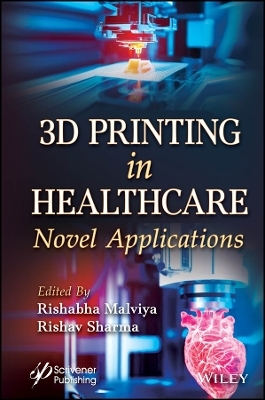
3D Printing in Healthcare
Wiley-Scrivener (Verlag)
978-1-394-23420-2 (ISBN)
In the fields of medicine, pharmaceuticals, surgical planning, and personalized medical treatment, the novel emergence of 3D printing technology has opened a wide range of potential applications. With personalized solutions that were previously impossible, 3D printing has opened up novel possibilities in patient care, from developing unique medications to manufacturing prosthetics and implants that are particular to each patient. The 14 chapters in this volume present the reader with an array of subjects including:
the evolution and background of 3D printing, charting its extraordinary path from its inauspicious origins to its current significance in the field of healthcare. Also discussed are the many kinds of 3D printers that are employed in additive manufacturing, as well as how they are modified for usage in medical settings;
the current developments in medical science brought about by 3D printing technology, including the clinical uses of 3D printed models in different medical domains, ranging from cardiovascular illness to tumors, and congenital heart disease;
personalized medicine and the creation of dosage forms utilizing 3D printing methods, the benefits and drawbacks of various 3D printing technologies and the applications of these technologies in healthcare, including the creation of immediate-release tablets, capsules, and implants for a range of illnesses;
the possibilities of 3D printed anatomical models for surgical planning, the roles of 3D printing technologies that are used to produce surgical guides, knee implants, spinal implants, and other patient-specific applications;
the current developments in 3D printed medication delivery devices including regulatory concerns;
the field of personalized medicine using 3D printing, and discusses organ models for preoperative diagnostics, permanent non-bioactive implants, local bioactive and biodegradable scaffolds, and direct printing of tissues and organs;
the different specialized uses of 3D printing in the medical field, covering topics including hospital management and administration, surgical training for urological operations, ophthalmology, and preserving safety and efficacy in point-of-care.
Audience
The book will be widely read by all healthcare professionals, biomedical engineers, researchers, and graduate students who are seeking to expand their knowledge of efficient techniques of 3D printing technology in the healthcare sector.
Rishabha Malviya, PhD, is an associate professor in the Department of Pharmacy, School of Medical and Allied Sciences, Galgotias University. He has authored more than 150 research/review papers for national/international journals of repute. He has been granted more than 10 patents from different countries while a further 40 patents have either been published or are under evaluation. He has edited about 50 volumes, of which many are under the Wiley-Scrivener imprint. His areas of research interest include formulation optimization, nanoformulation, targeted drug delivery, localized drug delivery, and characterization of natural polymers as pharmaceutical excipients. Rishav Sharma has completed his B Pharm from Kanpur Institute of Technology and Pharmacy, Kanpur, Uttar Pradesh India, and M Pharm from Galgotias University, India, where he is now an associate professor. He has authored four book chapters and published more than 10 journal articles.
| Erscheinungsdatum | 16.11.2024 |
|---|---|
| Sprache | englisch |
| Themenwelt | Mathematik / Informatik ► Informatik |
| Medizin / Pharmazie ► Gesundheitswesen | |
| Medizin / Pharmazie ► Medizinische Fachgebiete | |
| Technik ► Maschinenbau | |
| ISBN-10 | 1-394-23420-1 / 1394234201 |
| ISBN-13 | 978-1-394-23420-2 / 9781394234202 |
| Zustand | Neuware |
| Haben Sie eine Frage zum Produkt? |
aus dem Bereich


